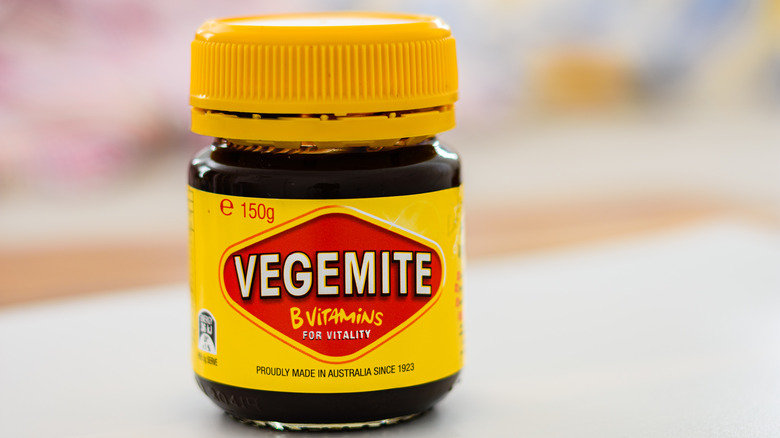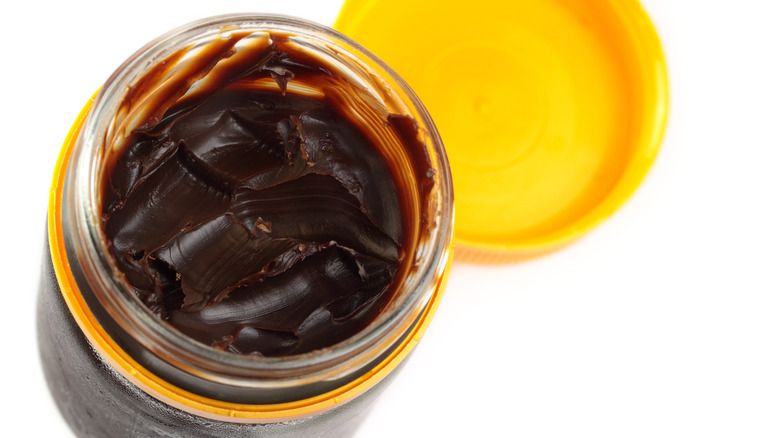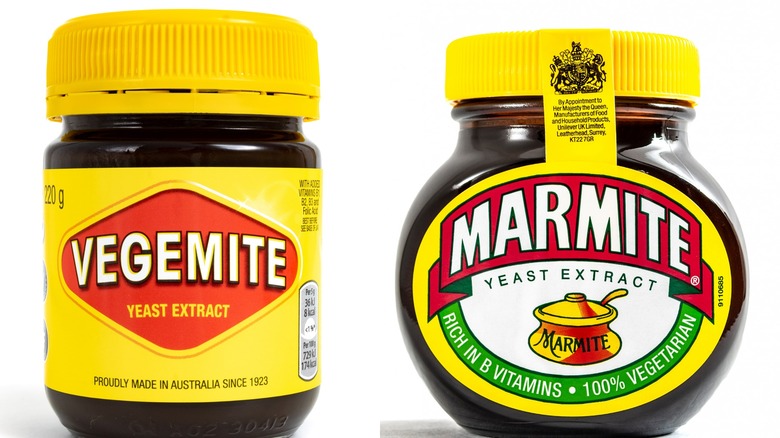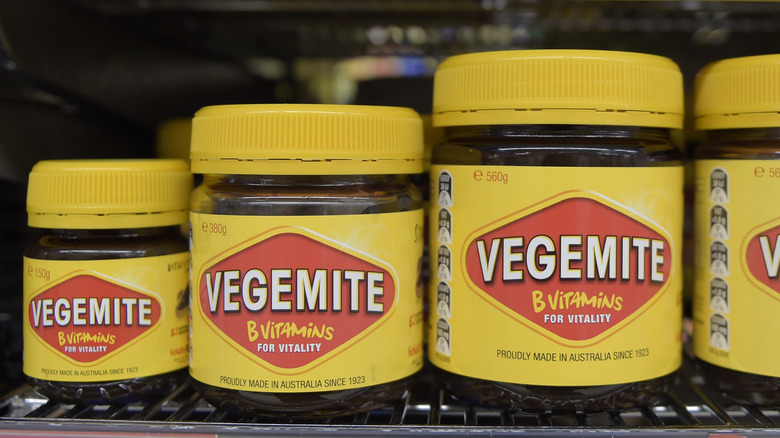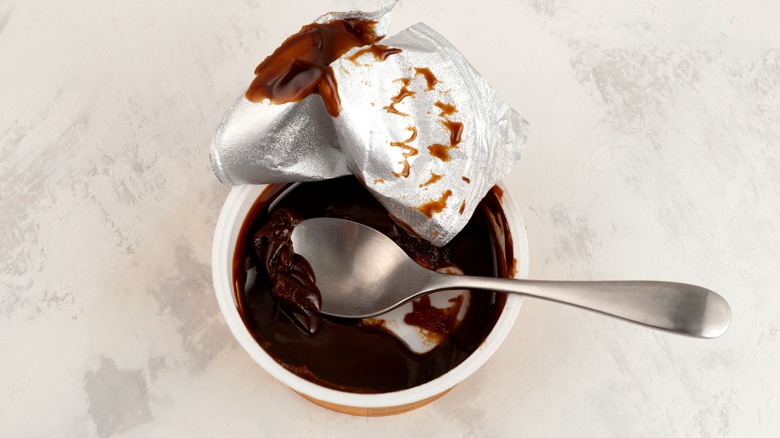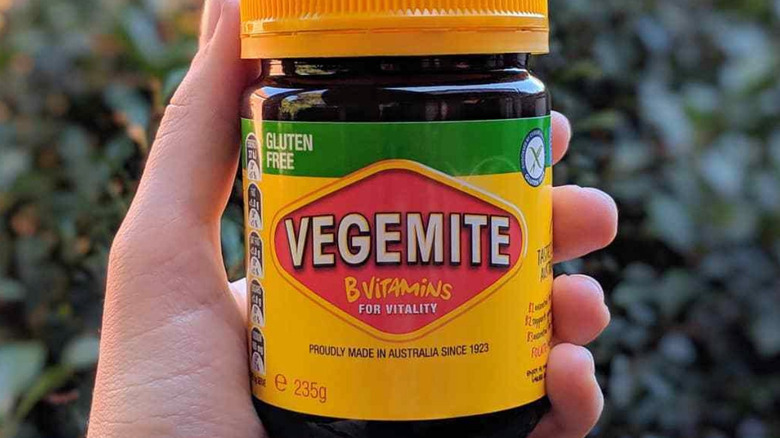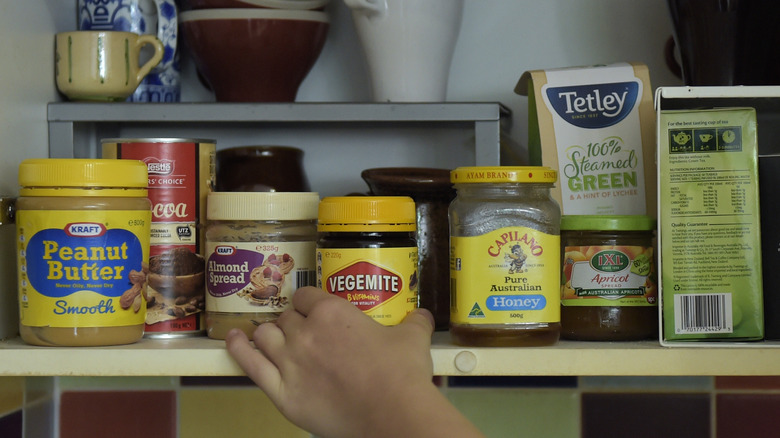What Is Vegemite And How Do You Eat It?
We may receive a commission on purchases made from links.
If your only familiarity with Vegemite is as a one-liner in an old Men At Work song — i.e. the lyric "She just smiled and gave me a Vegemite sandwich" — it's time to learn the real facts of this dark and mysterious spread. Like that band, Vegemite hails from Australia where it's enjoyed by locals daily on toast and in savory dishes or pastries. There are even a few desserts that balance sweet ingredients with a salty, umami-rich layer of Vegemite.
When you open a jar, you know in a second that this is no jam or any ordinary spread. Vegemite is dark brownish-black in color with a very thick, dense texture. But what really stands out about the infamous condiment is its pungent aroma and flavor. For the uninitiated, that first whiff and first taste make quite an impression — and often not favorably! Nevertheless, Vegemite is fiercely loved and staunchly defended by Aussies, and that makes it a food worth learning more about.
The history of Vegemite
Vegemite has been a favorite of Australians everywhere for 100 years, and its creation is thanks to wartime food shortages. In the early twentieth century the English yeast extract spread Marmite was a popular foodstuff in Australia, but at the height of World War I, it could no longer be shipped to the country. A young, Sydney-based food importer named Fred Walker saw an opportunity in the shortage, and in 1923 hired chemist Cyril Callister to develop a new yeast extract — one they named Vegemite. Although Vegemite looked like Marmite, it differed enough in flavor and texture that customers dismissed it, and its initial launch was a flop.
A few years later, Walker obtained the rights to produce and distribute Kraft processed cheese, a recent American innovation, in Australia. He also had the ingenious idea to sell packages of the cheese with a coupon for a free jar of Vegemite. Given another (free) chance to try the spread, the public grew to accept and love the flavor of Vegemite. It was even included in rations for Australian soldiers during World War II.
After Walker's death in 1935, the U.S.-based Kraft Foods company took full ownership of Vegemite. Fast forward to 2017 when Aussies had a big reason to celebrate: the Australian company Bega Cheese Limited bought the brand from Kraft, making Vegemite a truly Australian product in every respect.
How Is Vegemite Made?
The label on a jar of Vegemite identifies the spread as a yeast extract. But Vegemite looks nothing like the packets of dry yeast we buy for baking — so what exactly does yeast extract mean?
Vegemite owes its existence to the beer industry: the spread is made from ingredients that are leftover from brewing and would otherwise be discarded. Beer is created in part by feeding sugar to yeast cells; the Vegemite label specifies that these brewer's yeast have been raised on barley and wheat grains. The yeast cells multiply as they eat and ferment the sugar into beer, and at the end of the fermentation process, the yeast cells are no longer needed. The liquid containing the yeast cells is shipped from breweries to the Vegemite factory in Melbourne.
The liquid is heated until the cells are dead and then processed to remove the cell wall material. The cell matter that remains is heated again to steam off excess water, leaving behind a thick, dark substance — the yeast extract. From there other ingredients are blended into the yeast extract, including salt, vegetable juices, and vitamins, to create the unique flavor and nutritional profile of Vegemite.
Vegemite Vs. Marmite
There's another yellow-labeled, small jar with a mysterious, dark spread inside, and this one is called Marmite. There's a lot that Marmite and Vegemite have in common: both are yeast extract spreads, made from discarded yeast supplied by beer brewers. They both have added flavoring from salt and vegetable extracts, and both are fortified with vitamins and nutrients. And they both have a pungent smell and a flavor that quickly divides those who dare taste them — with diehard fans on one side and those who vow never to go near the stuff again on the other side.
As for differences, one is that they're produced in different countries. While Vegemite is an Australian creation, Marmite is British, made in the town of Burton-On-Trent in central England. The spread has been around since 1902, whereas Vegemite is a little younger, by about 21 years.
There are also differences in texture and flavor. While Vegemite is thick and paste-like, Marmite is more viscous with a sticky texture that's sometimes compared to corn syrup or molasses. Vegemite also has a more intense and bitter flavor than Marmite, and more vegetable flavor as well.
What Does Vegemite Taste Like?
Even those who think they know nothing about Vegemite have at least heard it has a funky flavor. Which brings up the question that most folks have about the spread: what does Vegemite actually taste like?
Vegemite is so pungent that a very little bit of it goes a long way. Because it's derived from brewer's yeast, the concentrated spread has flavors of darkly toasted bread, some bitterness, and a malty flavor that you'd find in stout beers. From behind these stronger flavors, the taste of vegetables also comes through. However, the most overwhelming sensation from Vegemite is that of salt. This spread is really, really salty. It's almost like eating a cube of bouillon, something meant to be diluted in a lot of water — but with Vegemite, there's no diluting or muting that salty, umami flavor.
Some say that Vegemite tastes somewhat beefy or meaty — however, the spread is actually meat-free and is both a vegetarian and vegan food. What comes through as meatiness may be a combination of the salt, the intense, rich flavor of the yeast, and the vegetable notes, almost like that of a salty and veggie-filled beef stew.
Where To Buy Vegemite
It goes without saying that if you're traveling to Australia in the near future, plan on grabbing a few jars of Vegemite while you're there to bring home in your checked luggage. If you're not heading to the land down under anytime soon, then the easiest way to get Vegemite is to order it from online retailers like Amazon who sell it in jars or squeeze bottles. Online stores that specialize in Australian or international foods are also a good bet.
Finding Vegemite at U.S. stores may prove to be tricky, but it's a possibility in supermarkets or retail outlets that have diverse international sections. Another option is to check World Market locations or other stores that import foods from around the world.
Here's one last way to track down some Vegemite: the Australian Embassy has a convenient, online list of Australian-owned eateries located across the United States. If there's one near you, swing by to see if they sell Australian goods — like Vegemite — and ask if any of their dishes are made with the spread. Even if they don't sell it, the Aussie owners will undoubtedly know if there are any nearby stores that stock their favorite, salty condiment.
Nutritional Information About Vegemite
The ingredients listed for Vegemite are yeast and malt extracts, salt, some artificial coloring, extracts from onion and celery, and added nutrients. The nutritional information on the spread indicates a serving size of four grams of Vegemite, which is just under a teaspoon, contains eight calories and one gram of protein. It contains scant amounts of saturated fats and carbohydrates from sugar.
Four grams of Vegemite contains 140 milligrams of sodium; for reference, the Food And Drug Administration recommends no more than 2,300 milligrams of sodium per day. Fortunately, Vegemite is so concentrated and intense that it doesn't take very much to add flavor to food.
As for nutrients, a serving of Vegemite provides four different B vitamins, which help support brain and organ health. The most prevalent B vitamin in Vegemite is B3 or niacin, which Medical News Today shares helps support the health of skin, nerves, and the digestive system. At the time it was introduced, and even in some sources today, Vegemite was promoted as a health food because of these high levels of B vitamins.
Varieties of Vegemite
It's hard to improve on a classic — and risky to mess too much with a product that customers know and love. Just ask the marketing execs who tried and failed miserably to launch New Coke back in the '80s. This may be why there are only a few Vegemite variations available from the company.
Those who have to watch their sodium intake but still want some funky Vegemite for their toast will be thrilled to know that there's a reduced salt version available. The company's website shares that it has 40% less sodium than regular Vegemite. And, yeast extract lovers with celiac disease or gluten intolerance can pick up a jar of gluten-free Vegemite, made with yeast grown with non-gluten food sources.
Finally, for those looking for a milder Vegemite experience, the brand offers jars of Vegemite & Cheese (also sold as Kraft Vegemite Cheesybite). It's a smooth spread made of Vegemite blended with Bega-brand cream cheese, which helps mellow the intense flavor.
How to store Vegemite
No refrigeration is necessary for this spread — it can live in the pantry or cupboard right alongside the peanut butter and Nutella. The Vegemite website shares that their yeast extract is stable at room temperature, and good to eat up to the expiration date stamped on the jar, which incredibly is about a year from the time it's packaged.
While that might be the official word on the matter, the rumor is that an opened jar of salty Vegemite will last beyond the expiration date ... possibly forever. One Reddit user shared his story: he had been using his Vegemite for so long that he couldn't remember when it was purchased. The date on the jar revealed the answer: it had expired 11 years ago. A comment on the post joked that "Vegemite is to Australians what honey was to the ancient Egyptians. You will be ok to uncover a jar from a grave in 2,000 years and still use it."
To make sure your Vegemite stays fresh don't stick a knife into the jar that has other food on it, such as butter. Contamination from other foods could cause Vegemite to develop off flavors or get moldy.
How Australians eat Vegemite
One of Australians' favorite ways to eat Vegemite is on toast, a treat beloved by children and adults alike. However, there's a proper way to make this simple dish; Vegemite newbies often make the mistake of trying to eat a thick layer of the spread. Aussie and "The Greatest Showman" star Hugh Jackman schooled Jimmy Fallon of "The Tonight Show" on authentic Vegemite toast. First, he says to use the "crappiest" white bread available. Toast it, then spread on a thin layer of butter; when that's melted, add a very small amount of Vegemite — about a half-teaspoon — and spread it over the toast. The flavor is so salty and intense that this minuscule amount is all that's needed.
Vegemite on buttered toast qualifies as a Vegemite sandwich, but it's also delicious in sandwiches with avocado and tomato, or spread inside a grilled cheese sandwich. To deepen the flavor of savory foods, add a little Vegemite to meat dishes like hand pies, beef stew, and shepherd's pie. Bake it into cheesy breads and rolls. Stir Vegemite into gravies, mac and cheese, or chili for a little umami oomph. Vegemite also pairs surprisingly well with chocolate and browned butter desserts.
For those who still feel Vegemite hesitant, just ask yourself: do you like salty foods? Do you like finding creative, funky umami flavors to add to snacks and other recipes? If you answered yes to either of these, then Vegemite is definitely worth a taste test. Just remember that a very little bit is all you need to experience that unique Australian flavor.
